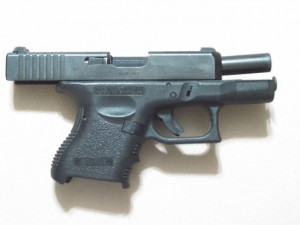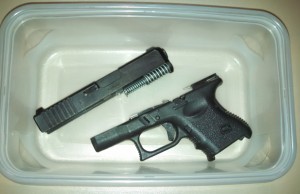From my email box:
“Always treat every gun as loaded. What do you do when you’re cleaning your guns? I try to follow this rule too but I’d admit I’ve broken it to look down the barrel of a gun, etc in the cleaning process. Now I always check and double check to make sure I’m not looking down the barrel of a loaded gun and there’s no finger on the trigger but it still makes me nervous to do it. But sometimes it’s necessary. So how do you handle that?”
As the letter writer points out, one of the most important questions raised by the safety rules is, “What’s a gun?” We don’t point a gun at things we’re not willing to shoot. We don’t put thoughtless fingers on the trigger of a gun. We choose a safe direction whenever we handle a gun. And on and on. So this becomes a critical question: What is a gun? More important, what isn’t a gun?
The definition I use, and which has stood me well for many years, is simply this: A gun is anything that can launch a bullet. If it cannot launch a bullet, it isn’t a gun. Please note that this definition has nothing to do with whether or not a bullet is present. It has to do with the thing itself. If the thing can fire a round of ammunition, it’s a gun. If it can’t, it isn’t.
Using this definition, a disassembled gun is not a gun. It is simply a collection of parts that can, with time and care, be put together to create a gun.
For the well-trained shooter, it takes neither much time nor special care to fire a round from an unloaded gun or from a gun with its action locked open. We see that every time we practice our reloads for competition or for self defense. For this reason, the simple act of unloading the gun, or of locking the action open, is not sufficient to turn the working firearm into “not a gun” for safety-rules purposes.
Breaking it down
With that background definition in mind, the thorny question about how to handle guns while cleaning becomes much more simple. It practically answers itself! Until the gun has been broken down to the point where it can no longer launch a bullet, I continue to treat it with the cautious respect I’d give a loaded weapon. But once the slide or cylinder has been removed, or the gun otherwise taken apart and disabled, I can treat the pile of gun parts with a much more relaxed attitude. If I need to look down the barrel to be sure it’s really clean, that’s no big deal — because when it’s not attached to the rest of the gun’s parts, that barrel is nothing more than a piece of metal that could never launch a bullet.
If I wanted to clean guns with my students in the classroom, I would have a bucket full of sand or a Safe Direction pad or a clearing barrel set up to provide a true, solid backstop. Then I would allow the students, one at a time, to break each gun into its major components while keeping the muzzle pointed pointed only at that safe backstop. If each student brought a shoebox or small plastic box over to the backstop station, they could easily drop the disassembled pieces into that box and then take the pieces over to their cleaning areas with no risk to themselves or other students.
When the gun needs to be reassembled and function-tested, it can be partially put together and then returned to the backstop station for the final steps. That means the muzzle will always be pointed in a safe direction as the gun becomes able to launch a bullet, and you won’t have students inadvertently muzzling each other or the walls as guns go into battery.
I’d still keep ammunition out of the classroom environment, of course — just as I keep ammo out of the room while cleaning the gun at home. But that’s the second layer of safety, not the primary one. The primary layer of safety is an ironclad habit of handling the firearm with respect.







3 Responses to Disassemble